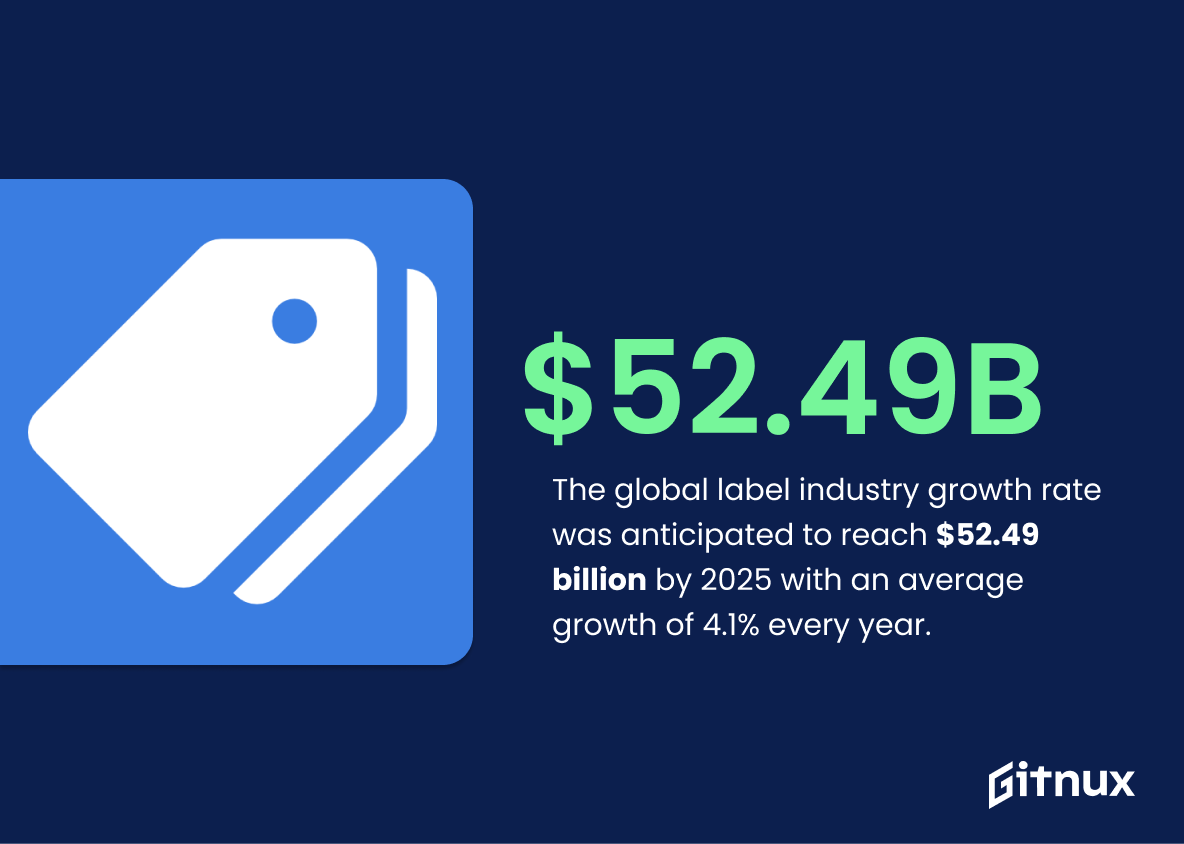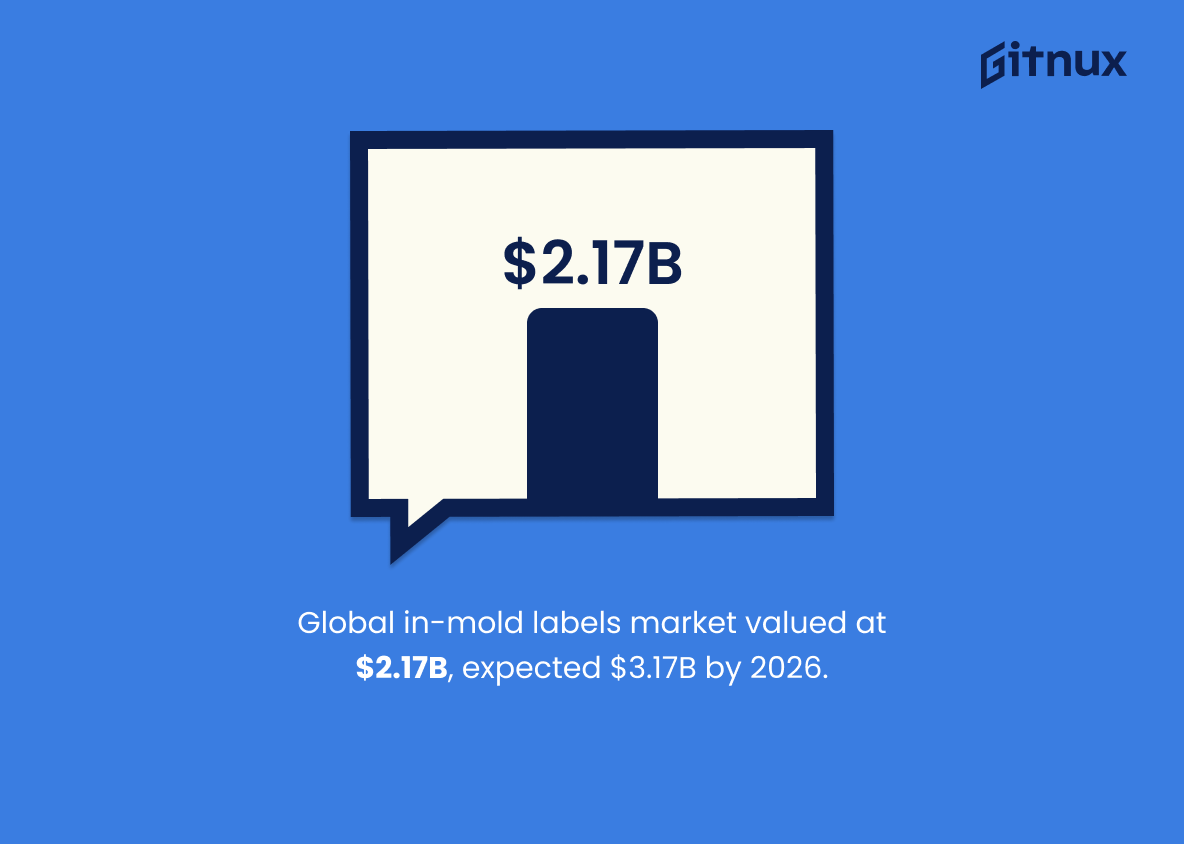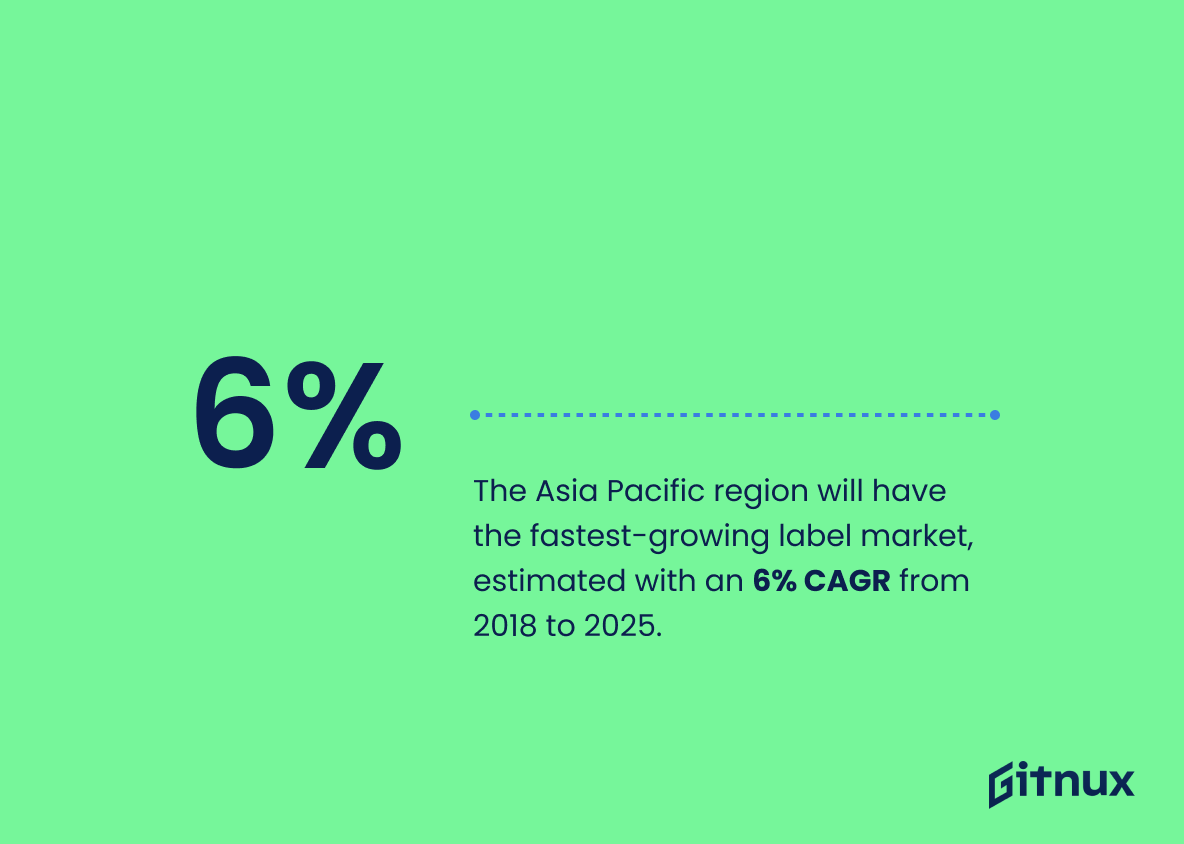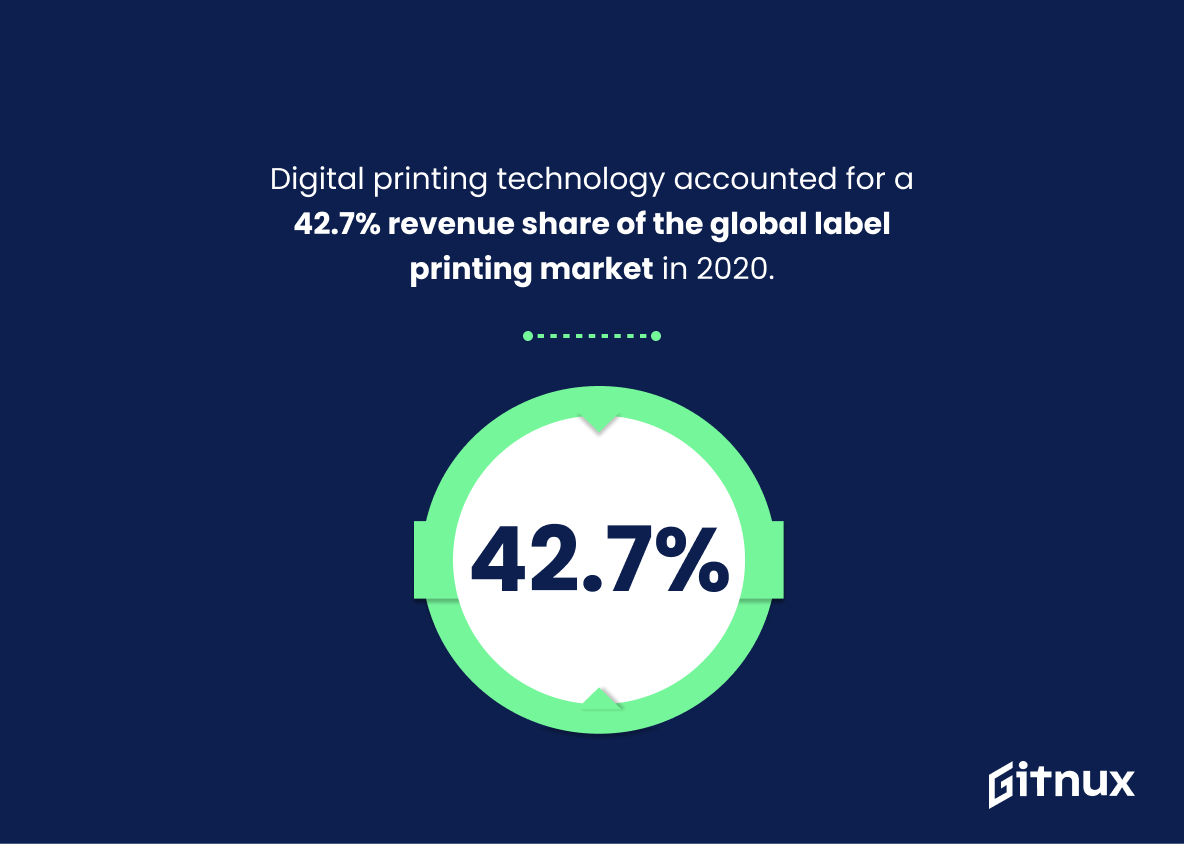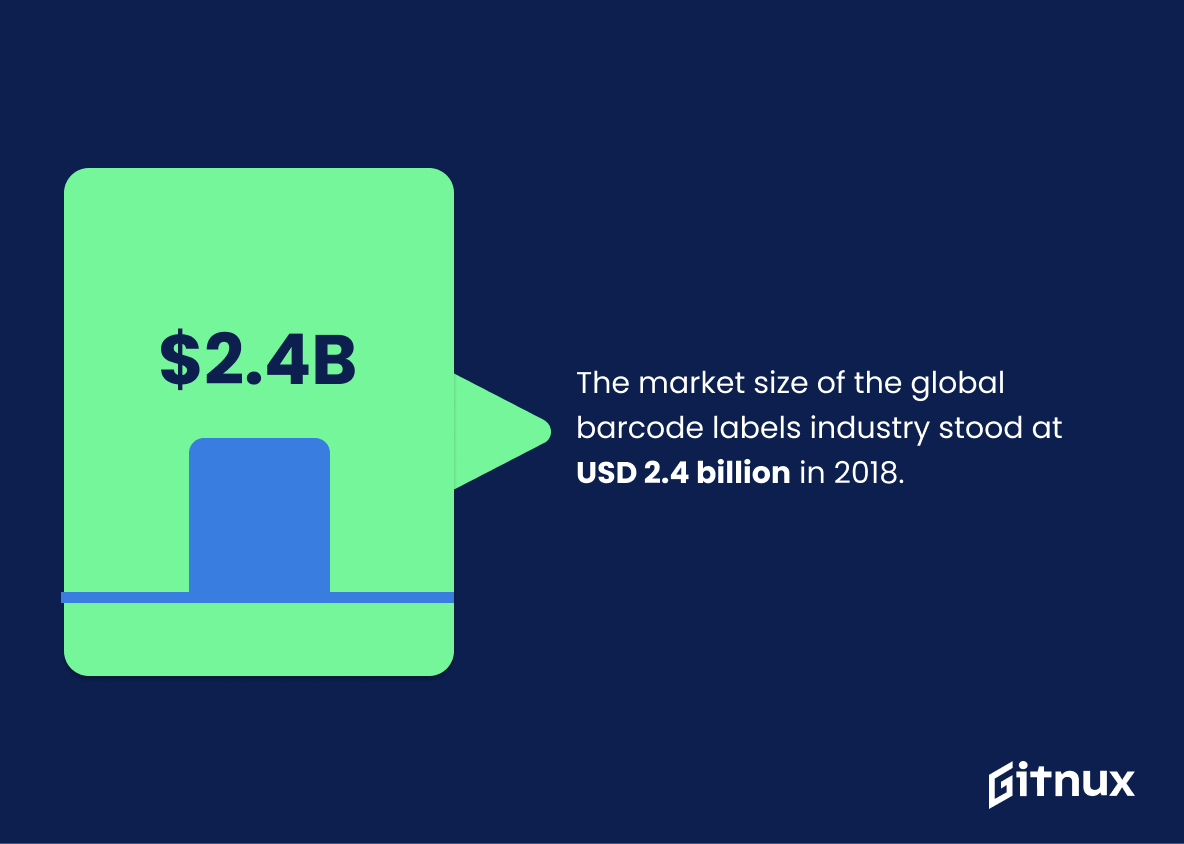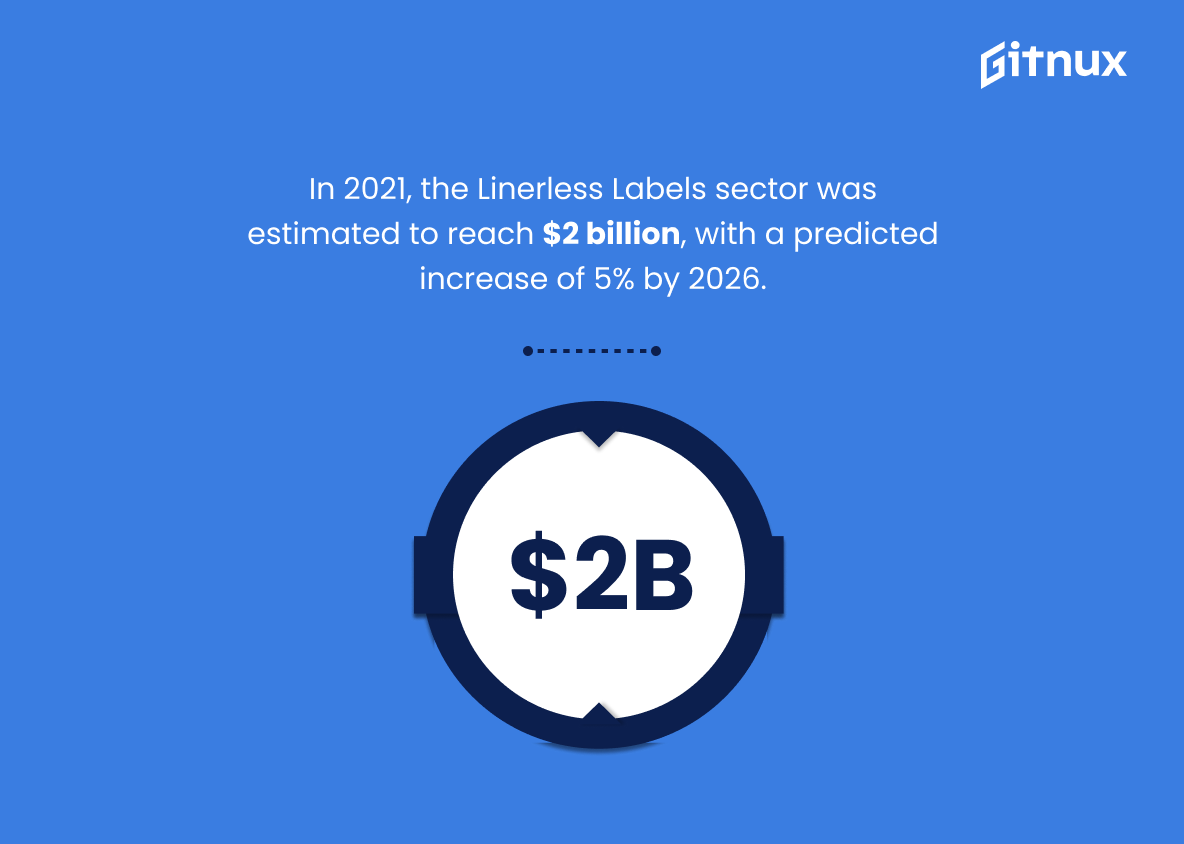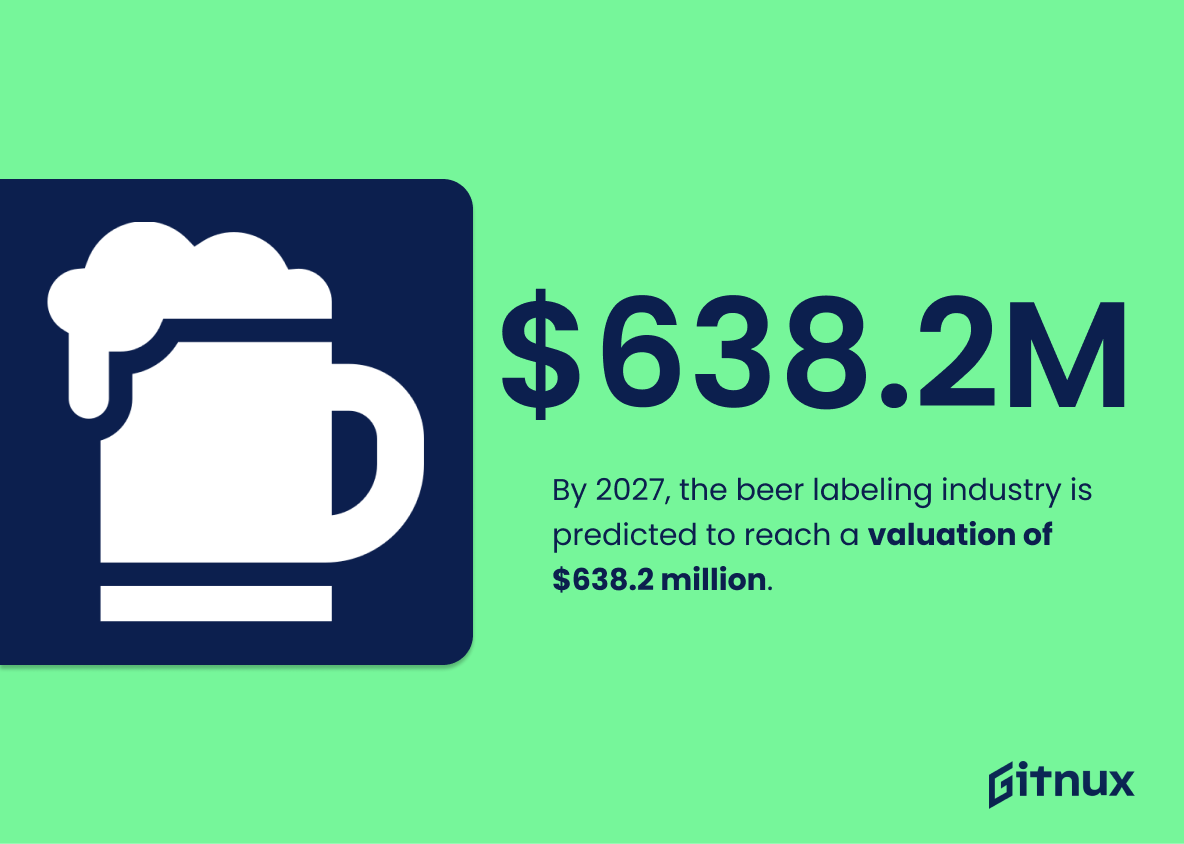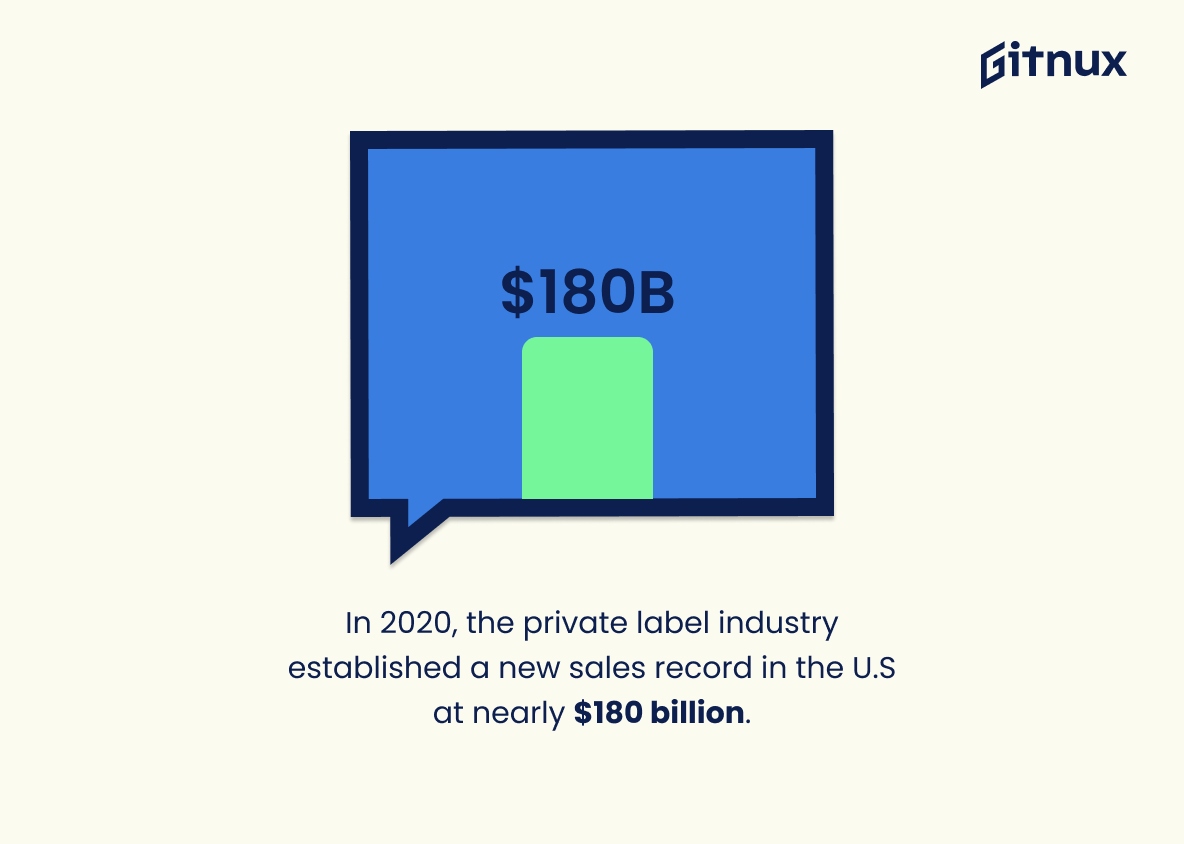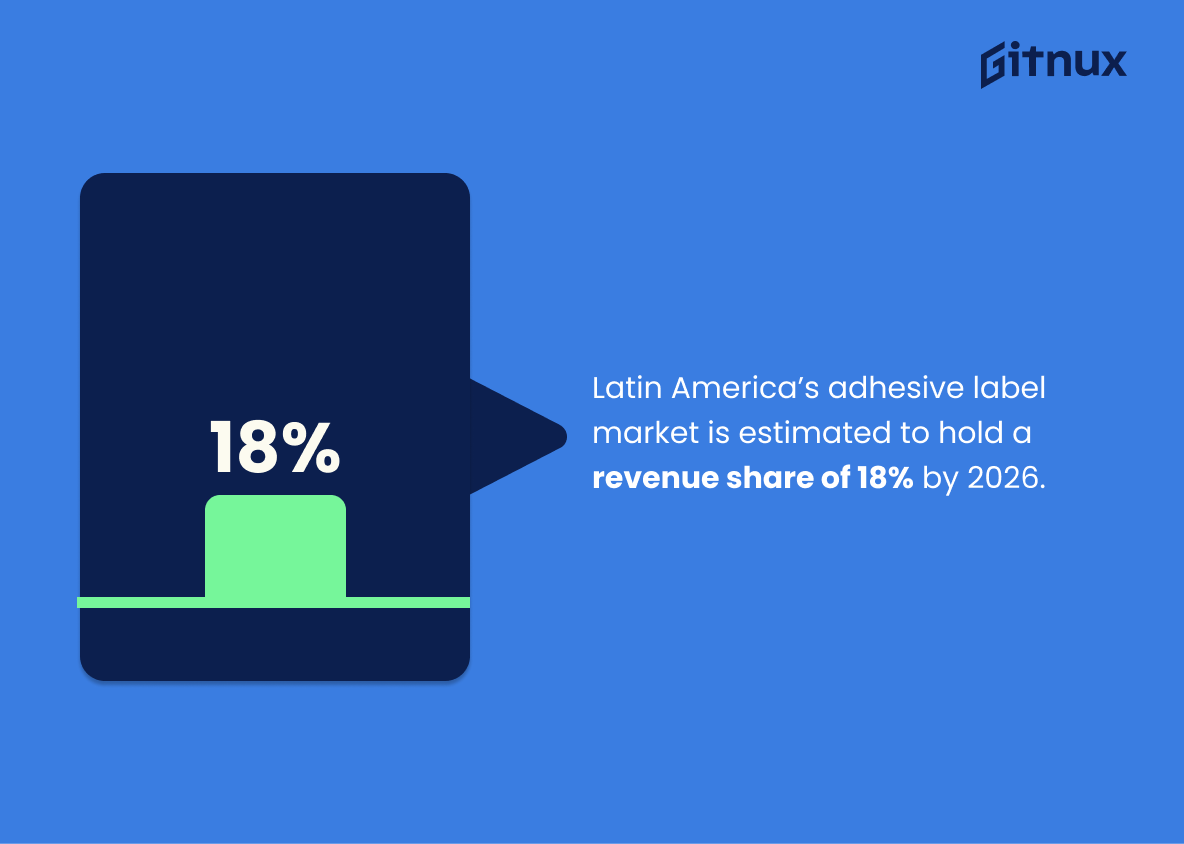In today’s fast-paced, consumer-driven world, labels play a crucial role in influencing purchasing decisions, conveying critical product information, and serving as a brand’s visual ambassador. Yet, how often do we truly pause to acknowledge their influence and understand the industry behind them? In this blog post, we dive into the dynamic world of the label industry, shedding light on evolving trends, growth trajectories, and key statistics.
We’ll delve into the numbers that empower this multimillion-dollar industry, offering readers like you a detailed, data-driven perspective. Whether you’re a packaging enthusiast, a brand owner, or just curious about the world hiding behind your product labels, these label industry statistics are sure to provide you with invaluable insights.
The Latest Label Industry Statistics Unveiled
The global label industry growth rate was anticipated to reach $52.49 billion by 2025 with an average growth of 4.1% every year.
The pulsating heart of the blog post beats with the rhythm of hard facts – the global label industry forecast to summon a massive $52.49 billion by 2025, the growth rate rhythmically ticking at a steady 4.1% per annum. These numbers aren’t mere digits, but the life-stream of the label industry, projecting a beacon of steady progression.
Striding on this growth trajectory, businesses can strategize their action plan, investors can weigh their returns, and startups can dissect market opportunities. The forecasted figures act as a telescope enabling us to palpably view the label industry’s pipeline, making this data nugget more than just ink on a page. It’s the very pulse of progress in the label industry, syncing its beat with the vibrant dance of numbers on a graph.
The global in-mold labels market size was valued at USD 2.17 billion in 2018 and is projected to reach USD 3.17 billion by 2026.
Peering through the lens of the provided statistic, we unravel a compelling narrative charting the explosive growth of the in-mold labels market. Embarking on its journey at a respectable USD 2.17 billion in 2018, the market is projected to catapult forward, tantalizingly poised at the brink of USD 3.17 billion by 2026. The anticipation of such a leap offers not just a wealth of insights for label industry observers, but it also signifies potential opportunities for market players.
This numerical tale holds a particularly significant standing among other statistical stories in a blog post about Label Industry Statistics. It illuminates a considerable growth trend and demonstrates the in-mold labeling segment’s substantial contribution to the larger label industry. Simultaneously, it prompts a deeper exploration of the factors propelling this surge, such as technological advancements, consumer preferences, or economic dynamics.
Resolutely anchored in hard data, this statistic serves as a guiding star for strategists, investors, and even competitors, nestling them safely in their decisions. Furthermore, it sparks interesting conversations around future market trajectories, innovative developments, and disruptive trends that may re-shape the landscape of the global label industry. So, as we peruse such figures, we’re not just recounting monetary values, but we are narrating the evolving saga of an industry on the move.
The Asia Pacific region will have the fastest-growing label market, estimated with an 6% CAGR from 2018 to 2025.
With our eyes set on the global label market landscape, it’s hard to ignore the notable crescendo of the Asia Pacific region. Ensconced in a strong 6% Compound Annual Growth Rate (CAGR) projection between 2018 to 2025, this figure unearths a plethora of possibilities. This exponential surge not only underscores the booming dynamics of this region but also paves the way to untapped business opportunities.
For readers seeking valuable insights regarding shifts in the label industry, this key finding amplifies the Asia Pacific region as a promising arena for business growth, investment, and market expansion. An intriguing testament to the region’s evolving consumer behavior, flourishing industries, and increasing adoption of digitization, which all together catalyze its burgeoning label market.
The European label industry is expected to reach $18.9 billion by 2027, growing at a CAGR of 2.8%.
Projecting the explosive growth of the European label industry to $18.9 billion by 2027, at a rate of a 2.8% compound annual growth, is like shining a spotlight on a robust stage of opportunities. This notion promises not just a thriving future for businesses already in the industry, but it also maps an inviting landscape for new entrants and investors.
It provides an evidence for potential growth and expansion, qualifying as a key statistic to understand the trajectory of the industry. Furthermore, it enables businesses to make informed decisions about market penetration, production, and marketing strategies. Hence, the tempo of this growing industry is truly set by this robust economic prediction.
Digital printing technology accounted for a 42.7% revenue share of the global label printing market in 2020.
Unveiling the economic landscape of the label printing industry, it comes as no revelation to discover the prominent role of digital printing technology. Dominating with a colossal 42.7% revenue share of the global market in 2020, this gives a nod to its profound influence and growing prevalence in this sector.
This statistic is a testament to the progressively digital-driven tapestry of the label industry, illustrating a notable shift from traditional techniques. It further underscores an era of technological transformation, offering a profound insight for businesses to align their strategies in the arena of label production and ensure relevance in ever-evolving market trends.
According to Adobe’s “State of Creative and Marketing Collaboration Survey”, 63% of creatives and marketers say outdated workflows lead to lost work and missing files, illustrating the need for better labeling systems.
The statistic derived from Adobe’s “State of Creative and Marketing Collaboration Survey” forms a striking pillar in a discourse about Label Industry Statistics. By unmasking the plight of 63% creatives and marketers who grapple with lost work and missing files due to archaic workflows, it galvanizes the call for innovative labeling systems.
The statistical insight not only amplifies the magnitude of the problem at hand but also fuels the case for why robust and efficient labeling solutions are no longer just an alternative, but an imperative in this digital age.
Over 64% of all consumers are likely to buy goods as a result of eye-catching and detailed product labels.
With over 64% of consumers swayed by eye-catching and detailed labels into making a purchase, the world of label industry stands as an untapped gold mine. This sweeping percentage flags the sheer influence of captivating, well-designed labels, that can play a game-changing role in the consumers’ purchase decisions. Thus, this statistic emerges as an imperative cue for those in the label industry, shedding light on an incredibly potent possibility of business amplification.
Through leveraging the power of creative, detailed labels, not only can businesses elevate their branding but also tap into the impulses of a vast consumer pool, proving what an indispensable asset an effective label can be.
In 2019, wine labels with animals on them sold twice as well as those without, highlighting the power of label design.
In the realm of label industry statistics, unraveling the intricacies of consumer choice can often resemble an unsolved riddle. Consider the 2019 discovery which demonstrated that wine labels featuring animal designs outsold those without by a 2:1 ratio. It’s a lesson in the silent yet persuasive dialogue between product and buyer.
This intriguing statistic emphasizes the potential of innovative label design to captivate consumers and dramatically escalate sales — a key insight for any entity in the label industry. It enhances the understanding of the undeniable symbiosis between product packaging and marketing success, serving as a beacon for those interested in crafting compelling label narratives.
The market size of the global barcode labels industry stood at USD 2.4 billion in 2018.
Painting a picture of the label industry without incorporating this striking figure would be much like attempting to sketch a portrait without adding in the defining features. This influential statistic of the barcode labels industry valuing USD 2.4 billion in 2018 integrates a key element to the canvas.
It not only highlights the financial magnitude of this subset, but also underlines its potential, both past and future, in the global label industry. Just like a strong bass line in a song, this particular statistic provides the steady undercurrent that helps us understand the rhythm and trajectory of the broader label market.
In 2021, the Linerless Labels sector was estimated to reach $2 billion, with a predicted increase of 5% by 2026.
The unfolding tapestry of the Label Industry lies not just in its vast expanse, but in the microscopic evolution of its specific sectors such as the Linerless Labels sector. Delving into the crux of this sector, we uncover an exhilarating revelation. The value of the Linerless Labels sector was believed to be hovering around the $2 billion milestone as of the year 2021.
However, the true marvel of this sector unveils in the forecasted streak of growth that it is set to march on. By 2026, it is predicted to inflate by an additional 5%. These numbers serve not just as testament to the sector’s present stature, but act as a crystal ball towards a future of potential growth, innovation, and opportunities in this sector, shaping the way for strategies, investments, and decisions within the Label industry.
By 2027, the beer labeling industry is predicted to reach a valuation of $638.2 million.
Delving deep into this prolific prediction offers us a glimpse into the future of the label industry, particularly the beer labeling segment. Reflecting a potential valuation of $638.2 million by 2027, this statistic underscores the exponential growth trajectory and the evolving dynamics of the market.
This valuation not only suggests an optimistic future for manufacturers in this industry but also serves as a benchmark for other industries in terms of sustainability, innovation, and technology in label production. Paging through such bold predictions, thus, illuminates the broader canvas of label industry statistics, demonstrating the sector’s ability to adapt, flourish, and set new paradigms.
In 2020, the private label industry established a new sales record in the U.S at nearly $180 billion.
This remarkably high figure of nearly $180 billion set by the private label industry in the U.S in 2020, forms a critical cornerstone, highlighting unparalleled growth and potential within our blog’s exploration of Label Industry Statistics. It serves as a compelling testament to the sweeping popularity of private labels, a crucial trend for any market observer or participant to acknowledge.
Furthermore, it illuminates a wider discussion on identifiable shifts in consumer purchases and trust, and possibly, redefines the dynamics of competition between private labels and national brands, painting a future ripe with opportunities for the private label industry.
The Indian label industry has been growing at 8% per year, with an expected value of $2.5 billion by 2025.
Highlighted amid the ocean of label industry statistics, this buoyant figure illustrates the substantial strides the Indian label industry is making, gallantly galloping ahead with an 8% annual growth. Painted vividly against the canvas of 2025, it’s a staggering jackpot of $2.5 billion just waiting to be claimed, signposting a flourishing future for industry stakeholders.
This accelerating momentum of India’s label industry, cast against the global landscape, translates into a growing hub of opportunities, intriguing collaborations and cutting-edge innovations, which readers of this blog would find highly relevant and informative.
Latin America’s adhesive label market is estimated to hold a revenue share of 18% by 2026.
Diving headfirst into the riches of statistical data, you will uncover the gleaming gem that the adhesive label market in Latin America is predicted to grasp an 18% revenue share by 2026. This critical snippet of information shapes a vibrant image of the possible tremors on the landscape of the global label industry.
Not only does this forecast paint a vibrant picture of Latin America’s growing influence in this industry, but it also sets forth a ripple of intriguing questions that could further deepen one’s understanding. Is this region’s rising market share a reflection of advancements in local manufacturing or perhaps an increase in global demand for Latin American products? Or maybe both?
Moreover, it hints at enticing opportunities for businesses contemplating expansion, manufacturers seeking new markets, and investors scanning the horizon for rewarding ventures. In the vast narrative of label industry statistics, this statistic stands as a compelling subplot, shaping both the present and future dialogues surrounding this sector, marking Latin America’s position as a force to be reckoned with.
The pharmaceutical industry accounts for 18.3% of the global label adhesives market share in 2020.
In diving deep into the assorted layers of the label industry statistics, one naturally comes across intriguing revelations such as the significant imprint the pharmaceutical industry has cast on the global label adhesives market. Garnering an impressive 18.3% market share in 2020 indicates an intricate nexus between pharmaceuticals and label adhesives sphere.
This numeric ensemble portrays an enlightening insight into potential market trends, hinting towards a robust dependency of the pharmaceutical industry on label adhesives. Simultaneously, it signifies the extensive opportunities for growth and exploration for businesses in the adhesive industry.
Thus, in the grand canvas of label industry statistics, this particular figure stands as a vital checkpoint, a beacon guiding us to understand industry interrelations, devise prospective growth strategies, track industry progression, and forecast future trajectories.
The Middle East and Africa will exceed $1.6 billion in the label adhesives market by 2025.
Reading between the lines of numbers, this statistic heralds a milestone in the world of label industry. By forecasting that the Middle East and Africa will top the chart with a whopping $1.6 billion in the label adhesives market by 2025, it paints an impressive and promising picture of growth in these regions. This not only indicates an expanding market, but it also hints at an increase in industrial developments and economic uptrend within these territories.
For enthusiasts and entrepreneurs in the label industry, this serves as a compass, guiding them towards potential hotspots for investment or expansion. It’s like a beacon, underlining the emerging significance of the Middle East and Africa in the global adhesive label market. This data point is not just a number, but a tale of growth, opportunity and potential waiting to be seized in the label industry in the coming years.
More than 70% of global beer and soft drinks labels are pressure-sensitive, shrink-sleeve, or wraparound.
Diving into the label industry statistics, one cannot brush past the salient figure; an astonishing 70% of global beer and soft drink labels are either pressure-sensitive, shrink-sleeve, or wraparound.
Why is this significant you may ponder? Well, imagine walking down the drinks aisle in your local supermarket. The vast array of beverages before you offers more than just refreshment; they represent an industry driven by trends and innovation with the lion’s share currently in the realm of pressure-sensitive, shrink-sleeve, or wraparound labels. Therefore, any player in the label industry, big or small, cannot afford to take this statistic lightly.
This data point is not just about the numbers; it’s a fabulously colorful signpost pointing towards where the industry is headed. It gives invaluable insights to manufacturers, consumers, and marketers alike, helping them navigate the current marketplace dynamics by understanding the prevailing preferences and technologies in the industry.
In essence, the stirring reality that 70% of beverage labels utilize these three types of labeling technology stands as a testament to the ever-evolving industry landscape and becomes a guiding star steering future endeavors to meet consumer demands and stay competitive in this fizzy, bubbly world of drinks.
The global printed label market is anticipated to reach $62.35 billion by 2026, growing at a CAGR of 5.22%.
By highlighting the projection of the global printed label market reaching a worth of $62.35 billion by 2026, we notably underscore the vigorous, upward trajectory expected in the Label Industry. The anticipated growth rate of 5.22% CAGR is a crystal-clear indicator of a prosperous future for all stakeholders. This figure is not merely a number, but a narrating testament to emerging opportunities, consumer trends, technological advancements, and market dynamism.
It offers insightful guidance for businesses, researchers, and investors keen on understanding the vibrant ebb and flow of the Label Industry’s ecosystem, facilitating informed decision-making, strategic planning, and vividly illustrating the sector’s magnificent potential.
Conclusion
In essence, the label industry continues to exhibit dynamic growth, influenced largely by technological advancements, consumer expectations, and the relentless pursuit for business efficiencies. Scrutinizing the statistics reveals how important the labeling sector has become as a cornerstone of global commerce.
From product identification, branding, logistic control, to regulatory compliance, labels will continue to play a pivotal role in various sectors. Towards this ever-evolving future, staying informed of industry trends and market predictions paves the way for innovation, sustainability, and profitability in the label industry.
References
0. – https://www.www.adobe.com
1. – https://www.www.marketsandmarkets.com
2. – https://www.plma.com
3. – https://www.www.reportlinker.com
4. – https://www.printweek.in
5. – https://www.www.businesswire.com
6. – https://www.www.fortunebusinessinsights.com
7. – https://www.www.grandviewresearch.com
8. – https://www.www.alliedmarketresearch.com
9. – https://www.www.gminsights.com
10. – https://www.www.prnewswire.com
